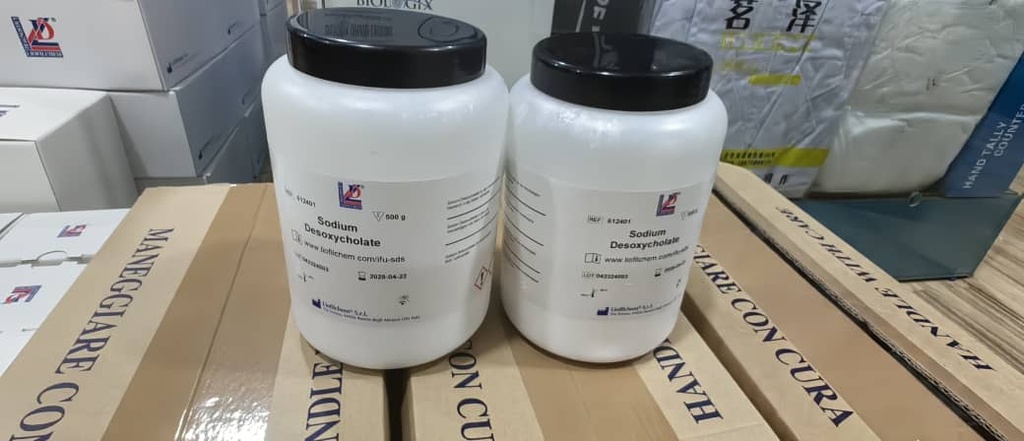Specifications:
| Application | Microbiology | ||
| Storage Temperature | Room Temperature | ||
| Product Type | Culture Medium | Forms | Powder |
| Product Brand | Liofilchem | ||
| Product Grade | Microbiology grade | Formula | C₂₄H₃₉NaO₄ |
Sodium Desoxycholate is a sodium salt derived from desoxycholic acid, a purified bile acid known for its inhibitory effect on Gram-positive cocci and spore-forming organisms. This compound is widely utilized in microbiological culture media to isolate and enumerate coliforms in dairy products, water, sewage, and for the detection of enteric pathogens. Its use is well-established in bacteriological applications, making it an essential component in laboratory culture media formulations.
Key Features
- Selective Inhibitory Agent:
- Inhibits Gram-positive cocci and spore-forming organisms.
- Facilitates the growth of Gram-negative bacteria such as coliforms and enteric pathogens.
- Applications:
- Widely used in microbiological culture media for milk, water, sewage, and food testing.
- Helps isolate enteric pathogens critical for diagnostic and research purposes.
- Highly Purified:
- Ensures reliable and reproducible results across various microbiological applications.
Physico-Chemical Characteristics
| Parameter | Standard Value |
|---|---|
| Solubility in Water | Soluble |
| pH (5% concentration) | 8.5 |
| Loss on Drying | 2.3% |
| Specific Optical Rotation | +44.5° |
Applications
- Microbial Enumeration:
- Enumerates coliforms in milk, water, and sewage.
- Determines microbial load in environmental samples.
- Enteric Pathogen Isolation:
- Used in culture media for isolating pathogens like Salmonella, Shigella, and other Gram-negative bacteria from clinical and non-clinical samples.
- Food and Beverage Safety:
- Included in culture media to ensure compliance with safety standards in food microbiology.
Preparation and Technique
- Preparation:
- Sodium Desoxycholate is incorporated into dehydrated culture media formulations.
- Dissolve in distilled or deionized water and sterilize by autoclaving as per the culture media requirements.
- Usage:
- Refer to specific culture media instructions for correct usage and concentrations.
- Typically used as an ingredient in media designed for selective bacterial isolation.
Quality Control
- Dehydrated Powder:
- Appearance: Free-flowing and homogeneous.
- Color: White.
- Prepared Media:
- Ensure solubility and uniformity upon incorporation into the medium.
Storage & Shelf Life
- Storage Conditions:
- Store at 10-30°C in a dry environment.
- Keep in its original container, tightly closed, to prevent contamination or deterioration.
- Shelf Life:
- Valid until the expiry date mentioned on the label, provided it is stored under recommended conditions.
Safety and Handling
- Classification:
- Does not contain hazardous substances in concentrations exceeding regulatory limits.
- It is classified as safe when handled by trained laboratory personnel.
- Precautions:
- Consult the Safety Data Sheet (SDS) for information regarding safe handling and disposal practices.
References
- Leifson, E. (1935). J. Pathol. Bacteriol. 40: 581-599.
- APHA (1967). Standard Methods for the Examination of Dairy Products, 12th Ed.
Packaging
| Product Code | Content | Packaging |
|---|---|---|
| 612401 | 500 g | Plastic Bottle |
| 6124015 | 5 kg | Plastic Bottle |
Product Benefits
- Provides a selective environment for Gram-negative bacteria.
- Reliable and widely used in microbiological diagnostics and quality control.
- Compatible with a range of media for coliform enumeration and pathogen isolation.
This versatile product is a key ingredient in laboratory culture media, ensuring precise and effective microbial detection for research, diagnostics, and quality assurance.




 0
0
